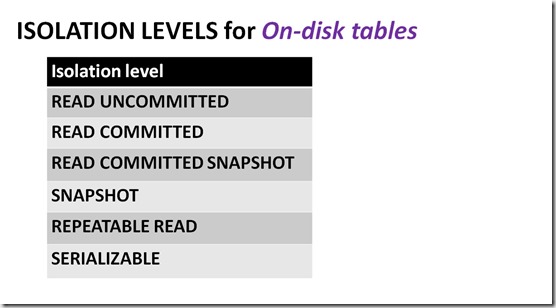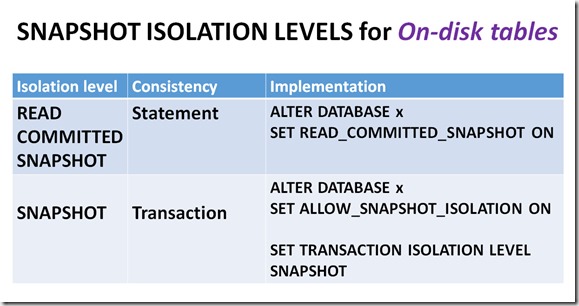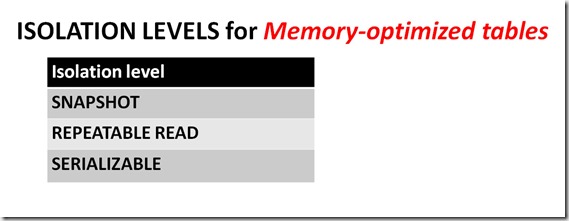Transaction initiation modes
If you want to understand the details of transaction isolation requirements for memory-optimized tables, you must first understand transaction initiation modes. That’s because the initiation mode affects what type of isolation levels are possible when referencing memory-optimized tables.
There are four different modes that describe the way in which a transaction is initiated:
Atomic Block – An atomic block is a unit of work that occurs within a natively compiled module (procedure, function, or trigger). Native modules can only reference memory-optimized tables.
Explicit – We’re all familiar with this mode, because it requires defining an explicit beginning for the transaction, and then either a commit or rollback.
|
1 2 3 4 5 6 |
BEGIN TRANSACTION IF COMMIT ELSE ROLLBACK |
Implicit – We’ll cover this mode for the sake of completeness, but I’ve not seen an implicit transaction in all my years of SQL Server. Implicit transactions require you to SET IMPLICIT_TRANSACTIONS ON, which then – for specific types of TSQL statements – has the effect of beginning a transaction for you. It’s only benefit is that it spares you from having to write your own BEGIN TRAN statement (woo hoo).
Documentation for implicit transactions can be found here.
Autocommit – If you execute TSQL statements outside of an explicit or implicit transaction, and outside of an atomic block, then for each individual statement, the SQL Server engine starts a transaction. That transaction is automatically committed or rolled back.
An example of an autocommit transaction would be:
|
1 2 3 |
UPDATE dbo.MyTable SET name = ‘Joseph’ WHERE TableID = 5 |
We did not create an explicit transaction with BEGIN TRAN, and we didn’t SET IMPLICIT_TRANSACTIONS ON, which would have allowed the engine to implicitly start a transaction. Therefore, this TSQL statement will be automatically committed or rolled back by the engine.
Isolation levels
Now that we have a basic understanding of transaction initiation modes, let’s move on to isolation levels. Isolation levels are what determine whether certain “concurrency side effects” are allowed, such as dirty reads (uncommitted data), or phantom reads. Please refer to the SQL Server documentation on isolation levels at this link or this link for specific details.
First, let’s display which types of isolation levels are available for each type of table.
List 1:
“Snapshot”
One thing I want to clear up right way, is how freely the word “snapshot” is used in the SQL Server documentation, the technology world in general, and how confusing this label is in the context of transaction isolation levels.
Some editions of SQL Server have the ability to create database snapshots, which use NTFS sparse files to make a “copy on write”, read-only version of a database. This type of snapshot has absolutely nothing to do with isolation levels.
The word “snapshot” is also used to describe saving the state of a virtual machine, i.e. Hyper-V, VMware, etc.
And there are also SAN snapshots, which create an image of your storage at a fixed point in time. Again, none of these types of snapshots have anything to do with isolation levels in SQL Server.
There are two variations of snapshot isolation in SQL Server:
- statement-level consistency – Within the context of a transaction, each statement sees consistent data as of the moment the statement executed. Other transactions can modify data while your transaction is executing, potentially affecting results.
- transaction-level consistency – All data that is referenced within the context of a transaction is guaranteed to be consistent as of the transaction start time. While your transaction is executing, modifications by other transactions cannot be seen by any statement within your transaction. When you attempt to COMMIT there can be conflicts, but we won’t cover that in this post.
Statement-level consistency is known as “read committed snapshot isolation”, while transaction-level consistency is known as “snapshot isolation”. Both can be enabled at the database level, while only transaction-level consistency can be set with the SET TRANSACTION ISOLATION command.
(wrapping your brain around variations of snapshot isolation will help you understand some of the nuances in the next post)
List 2*:
(*READ COMMITTED isolation is supported for memory-optimized tables, and we’ll cover that in the next post, but for now let’s concentrate on the isolations listed here)
If you are only querying on-disk tables, you can use any of the isolations levels from List 1. And if you are only querying memory-optimized tables, you can use any of the isolation levels from List 2.
But what if you want to reference both on-disk and memory-optimized tables in the same query? Of course, the answer is “it depends”, with transaction initiation modes and isolation levels being the components of that dependency.
As mentioned earlier, you can’t use native compilation to reference both on-disk and memory-optimized tables – instead you must use interpreted TSQL, otherwise known as “interop”. In the next post we’ll discuss the requirements for using interop to reference both on-disk and memory-optimized tables within a single query.



Pingback: Memory-Optimized Object Isolation Levels – Curated SQL